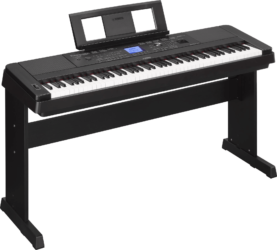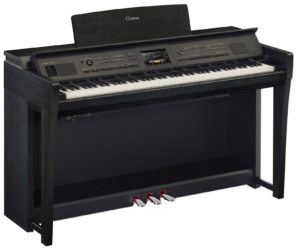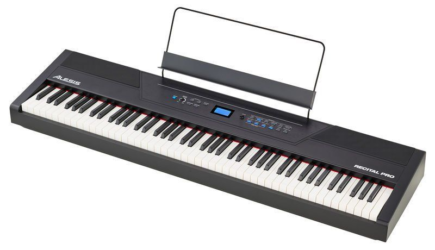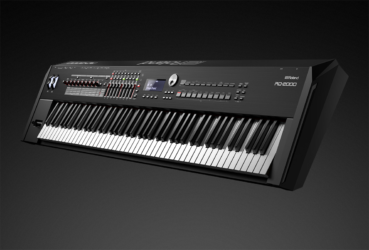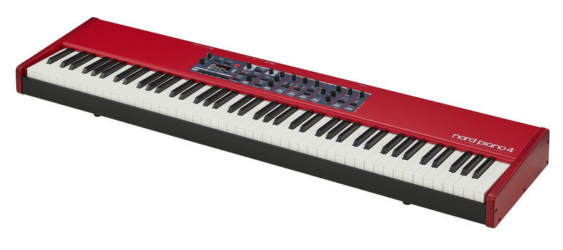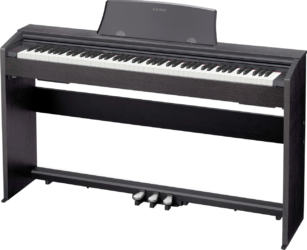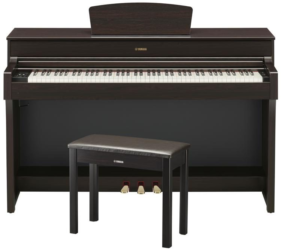In the 21st century, digital pianos have become just as popular as the traditional acoustic piano. With the assortment of tones, sounds, and effects that can be applied to their output, they can cover any genre of music you might want. Digital pianos also have useful training modes that can help players from all experience backgrounds take their practice sessions to the next level. No matter your goal, we’ll help you find the best digital piano to get you started.
- How to Choose the Right Digital Piano
- Top 10 Best Digital Pianos 2025
- 1. Best Overall Digital Piano: Yamaha DGX-660 88-Key Arranger Piano
- 2. Best Premium Digital Piano: Yamaha Clavinova CVP-805
- 3. Best Budget Digital Piano: Alesis Recital Pro
- 4. Highest Polyphony Digital Piano: Dexibell VIVO S7 Pro
- 5. Most Versatile Digital Piano: Roland RD-2000 88-Key Stage Piano
- 6. Best Digital Piano for Performances: Nord Piano 4
- 7. Best Digital Console Piano: Casio Privia PX-770
- 8. Best Digital Piano for Classical Players: Yamaha Arius YDP-184
- 9. Most Realistic-Feeling Digital Piano: Yamaha CP88
- 10. Most Portable Digital Piano: Casio CDP-S350 Compact Design
- Guide to Picking the Perfect Digital Piano
- Final Thoughts
How to Choose the Right Digital Piano
When it comes to picking out a digital piano, you’ll need to know what sort of musician you want to be. Are you planning to play recreationally as a hobby, become a classically trained pianist, or somewhere in between? We’ll only be looking at full digital pianos that have 88 weighted keys and pedal support. You can find a more in-depth guide to digital pianos later on.
Types of Digital Piano
Digital pianos can come in three different forms, which we’ll talk about below from the least affordable to most affordable. Keep in mind that the physical type of piano doesn’t limit its musical capabilities, as famous pianists like Emmanuel Ax use everything from slab pianos to grand acoustic pianos.
Slab
Slab pianos are built like a keyboard and need a stand (or you can place it on a table or the floor). They’re the most portable option and takes up the least amount of space, though the sound quality is not as good as the other two types. The pedals also need to be separately connected to the keyboard, and some may not come with pedals included.
Stage
A subcategory of slab pianos is stage pianos, which don’t have speakers installed. You’ll need to have your own headphones or speakers in order to hear notes that are being played, so keep that in mind before purchasing one of these.
Console
Console pianos have the keyboard integrated into the cabinet and pre-assembled pedals incorporated into the design. Each console piano has at least two flat side supports and a horizontal bar connecting the sides to keep it stable and upright. However, while you won’t have to worry about purchasing a stand, these digital pianos take up more space than slab pianos and are less portable.
Grand
Digital grand pianos can range from the size of a baby grand acoustic piano to a traditional grand acoustic piano. While they take up the most space, they can also be pleasing to look at and feel more like acoustic pianos when you play them. This extra size allows them to accommodate more strategically placed speakers for a realistic playing environment. Due to their size and specialist nature, they’re not usually sold online – and there are none on our list as a result.
Features to Consider When Buying a Digital Piano
Here are some of the main features and characteristics of digital pianos that you may want to keep in mind.
Sound Quality
Sound quality is the most important aspect to keep in mind when shopping for digital pianos. Some piano sounds are created through sampling standard pianos playing the notes, while others use physical modeling – employing mathematical algorithms to create the sounds the piano makes.
Touch Sensitivity
If a digital piano is touch-sensitive, then that means it can detect how hard or softly you depress the keys and adjust the volume accordingly. Touch sensitivity is a must if you plan on playing pieces that have a melody and harmony since you’ll want different dynamics for the two parts. If you’re looking to use your piano in performance, a touch-sensitive one is a must.
Speakers
The speakers that digital pianos come with are important as well, since they’ll determine the overall quality of the sound you’ll hear. In addition, some slab pianos don’t come with speakers installed, so you’ll need to purchase your own in order to hear the notes being played.
Portability
Do you plan to keep your digital piano in your room, or would you like to take it with you on vacations and trips? While slab pianos are relatively easy to move, once you get a digital grand piano set up, that’s where it’s going to stay. Some pianos, like the Casio CDP-S350, are especially light.
Voices/Tones
The voices and tones digital pianos have are the different sounds that they can play. For example, it can have sounds of various pianos, from concert grand to more electric pianos. It can also have other musical instrument sounds, like guitar, flute, percussion, and more. A piano with multiple tones allows you to test out different styles and music genres. The Yamaha Clavinova CVP-805 has over 1000 tones.
Effects
Much like voices, digital piano effects are another way to bring variety into your compositions. They can hold the notes out for longer, create chords and reverbs, and bring your piece to life by using the pre-installed effects.
Polyphony
Polyphony refers to how many sounds can be played at once from a digital piano. Some options only have 32 keys that can be played, while others have over 100 notes that can be played at the same time. At the minimum, you’ll want your piano to have a 64-note polyphony. One digital piano in particular, the Dexibell VIVO S7, has unlimited polyphony.
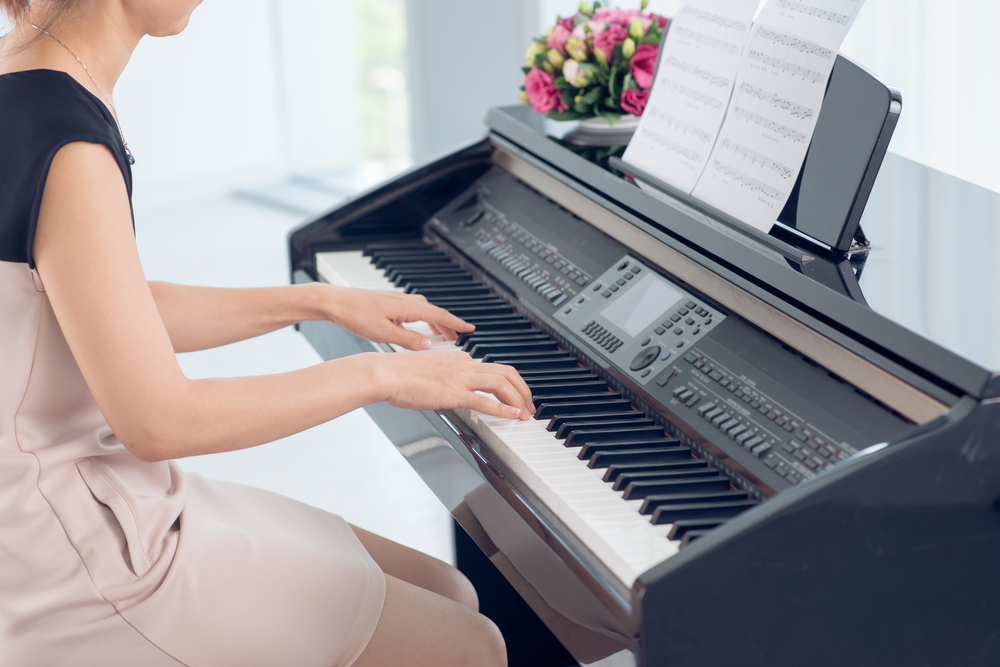
Digital pianos range from effect-laden composition machines to those with an acoustic look and feel yet with added features. Now that you have a basic idea of the features and characteristics of digital pianos, we’ll get into our top choices below.
Top 10 Best Digital Pianos 2025
1. Best Overall Digital Piano: Yamaha DGX-660 88-Key Arranger Piano
Why we like it:
The Yamaha DGX-660 is a digital piano with plenty of features that offer customizability and versatility for players of all backgrounds. The added compatibility with Yamaha apps can also offer guidance if you’re new to digital pianos.
Quick Specs:
- Video Link:Youtube
- Piano Type:Slab piano
- Dimensions:55.06” x 17.50” x 29.93” (with stand)
- Weight:46 lbs. 5 oz. piano, 15 lbs. 7 oz. stand
- Key type:Graded hammer action with touch response
- Polyphony:192 notes
- Accessories needed:Pedals, metronome, bench
- Tones/Sounds:554
- Effects:327 (Reverbs, Chorus, DSP, EQ, Acoustic Control)
This digital piano balances features with price, giving you a well-rounded option for your practice and performance sessions. With 554 tones and 327 effects, you’ll be able to create as many compositions as you want and make them sound however you like. They used precisely sampled 9’ Yamaha CFIIS concert grand notes so when you play, it sounds like it comes from an acoustic grand piano.
Since it is a Yamaha digital piano, it’s compatible with all Yamaha apps (though you will need to use an adapter to connect the piano to your phone). In addition, while it doesn’t come with a pedal, it’s compatible with Yamaha’s pedalboard. It’s also has a 6-track sequencer feature so that you can also dabble with producing and arranging music in addition to your playing.
However, the lower price point also means that the sound quality may not be as expressive as some other choices on the list, especially when compared to the Yamaha Clavinova CVP-805. In addition, some of the string samples do sound off, though the piano and organ sound samples are realistic.
Pros
- Samples from 9” Yamaha CFISS concert grand
- Compatible with all Yamaha apps
- Compatible with Yamaha’s pedalboard
- 6-track sequencer for production and arrangements
- More affordable than other options
Cons
- Not as expressive as the Yamaha Clavinova CVP-805
- String samples are lacking in quality
Why we like it:
If you only plan on making one digital piano purchase, look no further. The Yamaha Clavinova comes with everything you’ll need, whether you’re a beginner or a professional musician.
Quick Specs:
- Video Link:Youtube
- Piano Type:Console piano
- Dimensions:34.9” x 56” x 23.37”
- Weight:185.18 lbs
- Key type:GrandTouch weighted Graded wooden keys with Escapement
- Polyphony:256 notes
- Accessories needed:NA
- Tones/Sounds:1315
- Effects:266 (Reverbs, Chorus, Compressor, User)
The Yamaha Clavinova CVP-805 comes with everything you need, with pedals, speakers, and even a pre-installed metronome already set in this console piano. It comes with over 1300 tones and a sophisticated arranger system to help you bring your pieces to life. If you want a less expensive option with just as many tones, you should check out the Roland RD-2000.
The price point for the Yamaha Clavinova is much higher than other options, so this is only the right purchase if you know you’ll be practicing and playing piano for a long time to come. Some of the features are unnecessary for most, such as karaoke support. The extra features aren’t overwhelming however and can be safely ignored, so this piano is suitable for players of all skill levels.
The technological capacities of this console piano exceed many other choices as well, with Bluetooth support to connect devices to the piano for listening and playing. It also comes with a pair of 130W stereo speaker system already installed, which is loud enough for performances in your home. Like many other Yamaha digital options, it’s also compatible with the Smart Pianist app.
Pros
- Comes with pedals, bench, metronome, and speakers
- Contains over 1300 tones and nearly 300 effects
- Bluetooth support
- Good for pianists of all levels
- Compatible with the Smart Pianist app
Cons
- On the pricier side
- You may not need all features
3. Best Budget Digital Piano: Alesis Recital Pro
Why we like it:
If you’re just getting started with learning piano, the Alesis Recital Pro is an affordable option that has you covered. It still comes with hammer-action keys, a duet mode for learning, and an integrated metronome to help you play at the right tempo.
Quick Specs:
- Video Link:Youtube
- Piano Type:Slab piano
- Dimensions:13.8” x 51.6” x 5.5”
- Weight:26 lbs
- Key type:Hammer-action keys with adjustable touch response
- Polyphony: 128 notes
- Accessories needed:Pedals, stand, bench
- Tones/Sounds:12
- Effects:3 (Modulation, Chorus, Reverb)
The Alesis Recital Pro doesn’t come with many tones, but it covers all the basic ones. If you’re a beginner just looking to get started playing the piano, this is definitely the option for you. It’s budget-friendly and gives you a good taste for what digital pianos can do without needing a hefty investment on your end. It can also be divided into two zones for two people to play at the same time, perfect if you plan on taking lessons or want to teach a friend or sibling.
Unfortunately, the Alesis Recital Pro doesn’t have sound samples that are as high quality as some of the more expensive options, which can lead to more digital sounding notes. You’ll also have to make sure you have your own equipment at home since this digital piano doesn’t come with any pedals for you to hook up. While the keys aren’t as realistic pianos like the Yamaha CP88, they’re still weighted with hammer action.
Portability is where this product shines. The Alesis pro can operate on battery power or AC, so you’ll be able to take it with you and use it for performances where there may not be an outlet close by. It’s also very light, only 26 pounds, making this a portable option for travel. For beginners, it also has an integrated metronome to help you get the hang of rhythm and tempo.
Pros
- Good for beginners
- Can be divided into two zones for duets and lessons
- Can operate on battery power or AC
- Portable and lightweight
- Integrated metronome for rhythm and tempo
Cons
- Sound quality is more on the digital side
- Keys don’t feel as realistic as other options
- Doesn’t come with any pedals
4. Highest Polyphony Digital Piano: Dexibell VIVO S7 Pro
Why we like it:
The Dexibell VIVO S7 has unlimited polyphony for those who plan on creating complex pieces with hundreds of notes at a time. The design of the piano is ergonomic to help you survive those long, grueling practice sessions.
Quick Specs:
- Video Link:Youtube
- Piano Type:Stage piano
- Dimensions:5.03” x 50” x 13.94”
- Weight:39.46 lbs
- Key type:Graded, Hammer action, Triple-contact, Ivory feel
- Polyphony:Unlimited
- Accessories needed:Soft and sostenuto pedals, stand, bench, metronome, speakers
- Tones/Sounds:113
- Effects:12 (Reverb, EQ)
The Dexibell VIVO digital piano is one of the few available that has unlimited polyphony, meaning you can play as many notes as you want. Even with complicated pieces and compositions, this digital piano will be able to handle whatever you throw at it. Its design boasts a quad-core CPU that can process 320 digital oscillators so you’ll be able to simulate as much sound as you need at one time. This is a good choice for those seeking to create varied and extensive electronic soundscapes with a variety of tones and effects happening at the same time.
When it comes to design, the Dexibell doesn’t hold back. The controls on the piano are designed, angled, and placed in ergonomic locations for easy access, which makes long practice sessions much better. The keys themselves are created to feel like ivory, with graded hammer action that makes playing feel much more realistic. In addition, it’s compatible with SoundFont and you can easily upload more tones and voices to the piano as you need.
However, the design of the keyboard is a little lacking and doesn’t look as sleek as some of the other options. You also won’t have as much customizability when comparing it to the Roland RD-2000 since it doesn’t offer as many sliders and other adjustable options, even though the two are in the same price range. Finally, the LED screen is on the small side, which is a shame considering the complexity this keyboard is capable of.
Pros
- Unlimited polyphony
- Quad-core CPU that can process 320 digital oscillators
- Ergonomic design
- Ivory-like, realistic keys
- Compatible with SoundFont
Cons
- The design doesn’t look sleek
- Not as customizable as other expensive options
- Small LED screen
5. Most Versatile Digital Piano: Roland RD-2000 88-Key Stage Piano
Why we like it:
The Roland RD-2000 is one of the most adjustable stage pianos for performers and professional musicians, and is versatile enough for any genre of music. With LED indicators, knobs, and sliders covering the piano, you can manipulate your output to become any precise sound that you want.
Quick Specs:
- Video Link:Youtube
- Piano Type:Stage piano
- Dimensions:5.56” x 55.62” x 14.50”
- Weight:47 lbs. 14 oz
- Key type:Weighted Progressive Hammer Action
- Polyphony:128 notes
- Accessories needed:Soft and sostenuto pedals, stand, bench, metronome, speakers
- Tones/Sounds:1100 voices, 200 rhythm patterns
- Effects:Reverb, Delay, Resonance, Tremolo/Amp simulator, Modulation FX, 3-band compressor, 5-band EQ
The Roland RD-2000 comes with over 1100 voices and 200 rhythm patterns, giving you everything you need in your arsenal to create music in any genre. With this digital piano, you get access to a wide variety of knobs and sliders for extra adjustment and improved customizability. The flexibility offered by this piano is enough for professional and advanced pianists.
With the wide range of options comes with two sound engines, an expensive design choice that pays off when you hear the tones. It can even connect with your DAW and other virtual instruments! It also has authentic hammer action and an advanced sensor mechanism as well to make sure the keys are responsive to your touch and play at the appropriate volume.
However, with the large assortment of options comes a steep learning curve. If you’re just starting out, all of the choices can easily overwhelm you. The LED screen is also smaller than some of the other digital piano screens and can be harder to read and see what’s going on. It’s also on the heavier side for stage pianos, and is nowhere near as portable as the Casio CDP-S350, which may be an irritation if you’re traveling and performing with it regularly.
Pros
- Over 1100 voices and 200 rhythm patterns
- Improved customizability and versatility for any genre of music
- Responsive keys due to authentic hammer action
- Two sound engines
- Easy to connect with DAW and virtual instruments
Cons
- Steep learning curve
- Not suited for beginners
- Small LED screen
6. Best Digital Piano for Performances: Nord Piano 4
Why we like it:
Nord Piano 4 offers seamless transitions between different programs and voices along with a wide range of customizability when it comes to choosing sample sounds and effect options. It’s a great performance-grade piano.
Quick Specs:
- Video Link:Youtube
- Piano Type:Stage piano
- Dimensions:4.8” x 50.7” x 13.4”
- Weight:40.1 lbs
- Key type:Triple Sensor keys with Virtual Hammer Action Technology
- Polyphony:120 notes
- Accessories needed:Stand, bench, speakers, metronome
- Tones/Sounds:400
- Effects:Reverb, Delay, Phaser, Tremolo, Wah, Chorus, Flanger, Distortion
The Nord Piano 4 is built for performances, with smooth transitions when switching between sounds and lots of customizable effects for you to use. While it comes with 400 tones pre-installed, you can use the Nord Sound Manager to access the library of tones and manage the ones that you want to use. You’ll also be able to use controls for all the effects, such as filter, velocity, and more.
However, the excess of features means that this digital piano comes with a hefty price tag – and that’s not including the cost of the stereos you’ll need to invest in since speakers aren’t installed for this piano. The complicated features are better suited for advanced players and can easily overwhelm beginner pianists. For a digital piano with many options that aren’t overwhelming, you should consider the Yamaha Clavinova CVP-805.
While it doesn’t have real hammer action for keys, it does have virtual hammer action to make the playing seem more realistic. In addition, it comes with advanced string resonance to create a more realistic acoustic piano sound when played, and the available sample library makes possibilities endless when it comes to music creation. The extra features make it a bit heavier than other stage pianos, which makes transportation difficult.
Pros
- Smooth transitions when switching between tones
- Nord Sound Manager makes organizing sounds easier
- Dozens of effects and controls that can be implemented
- Advanced string resonance creates more realistic sound
- Tri-sensor keys
Cons
- On the pricier side
- Complicated features can be overwhelming
- On the heavier side for stage pianos
7. Best Digital Console Piano: Casio Privia PX-770
Why we like it:
The Casio Privia PX-770 is an affordable console piano that comes with all the basic effects and tones. The piano is set up so that you can play duets with friends or family and comes with everything except a piano bench.
Quick Specs:
- Video Link:Youtube
- Piano Type:Console Piano
- Dimensions:31.4” x 54.8” x 11.75”
- Weight:69.4 lbs
- Key type:Full size, scaled weighted hammer action, tri-sensor
- Polyphony:128 notes
- Accessories needed:Bench
- Tones/Sounds:19
- Effects:11 (Reverb, Chorus, Brilliance)
This digital console piano comes at an affordable price when compared to its competitors. It offers two different modes, with a dual-mode that lets you layer sounds on top of one another. The duet mode offered splits the piano into two smaller keyboards, so you can play duets with your family and friends without needing to invest in a second keyboard.
The speakers built into this console piano aren’t loud enough for real performances, and can’t get as loud as acoustic pianos. While you don’t need to purchase speakers, if the low level of volume bothers you, you may want to think about investing in some. In addition, this console piano doesn’t have a full cabinet like the Yamaha Arius, which can take away from the atmosphere.
While it doesn’t have an accompaniment function like some other choices, it does offer “Concert Play,” where it plays recordings of live orchestras for you to play with. With 10 different tunes, you’ll be able to practice the piano part on your own before playing with the orchestra recording. It also has a metronome included, so all you’ll have to really worry about is finding a piano bench.
Pros
- Affordable console piano option
- Two different modes for layering sounds
- Duet mode splits the keyboard in two for duets with friends
- Concert play lets you play with recordings of concerts
- All accessories except a piano bench are included
Cons
- Does not have the full cabinet of typical console pianos
- Speakers can be too quiet for large performances
- Does not provide an accompaniment function
8. Best Digital Piano for Classical Players: Yamaha Arius YDP-184
Why we like it:
The Yamaha Arius is as close to an acoustic piano as you can get while staying digital, as it has the overall look and feel of the traditional upright. Paired with Yamaha’s app, it’s perfect for any classical musicians who want benefits from digital pianos as they play.
Quick Specs:
- Video Link:Youtube
- Piano Type:Console piano
- Dimensions:36.5” x 57.5” x 18.06”
- Weight:123.43 lbs
- Key type:GH3 hammer action keybed with synthetic ebony and ivory keytops
- Polyphony:256 notes
- Accessories needed:NA
- Tones/Sounds:24
- Effects:27 (Reverb, Chorus, Brilliance, Master Effect)
The Yamaha Arius YDP-184 comes with everything you need to play piano, from the bench to the included metronome. A music rest is also included with your purchase, and you get all three pedals that can be attached to the bottom of the piano. In addition, the pair of 30W speakers are loud enough to fill even the largest room in your home with piano music once you start playing. The classic wooden design of the console piano is gorgeous and can easily set the mood of any interior.
It also only comes in 24 tones, which is less than many other options. It’s more suited for classical musicians who like original pieces, and isn’t nearly as versatile as the Roland RD-2000. The speakers are placed in the body of the console, so it feels like music is emerging from the piano itself and adds to the realism. In addition, it pairs with Yamaha’s Smart Pianist app which helps you explore the various features available.
The set-up process for this console piano can be difficult as well and can take a few hours to assemble. Once assembled, it’s heavy and challenging to transport on your own, so it’s best to assemble it where you plan on keeping it. The cables can also be tricky to hide away, and it comes with only some plastic routers to be used with tape.
Pros
- Authentic look that replicates acoustic pianos
- Realistic key feel due to hammer action
- Accurate sound samples for acoustic pianos
- Speakers are hidden in the body of the console
- Pairs with Yamaha’s Smart Pianist app
Cons
- Takes time to set up and assemble
- Cables are hard to hide from sight
- Lack of versatility for non-classical pianists
9. Most Realistic-Feeling Digital Piano: Yamaha CP88
Why we like it:
The Yamaha CP88 stage piano provides the pianist with a realistic and responsive keybed that’s hard for other choices to match. With a detailed design and construction of keys, the carefully crafted samples make playing on this piano much like playing on an acoustic piano.
Quick Specs:
- Video Link:Youtube
- Piano Type:Stage piano
- Dimensions:5.5” x 51.1” x 14.3”
- Weight:41 lbs
- Key type:Weighted, Graded Hammer
- Polyphony:128 notes
- Accessories needed:Soft and sostenuto pedals, stand, bench, metronome, speakers
- Tones/Sounds:57
- Effects:Master Delay, Reverb, and EQ
The Yamaha CP88 digital piano offers a premium keybed made from natural wood with an ebony and ivory finish. In addition, the keys themselves are triple-sensor keys to accurately detect light or heavy touches and adjust their volume accordingly. The keys themselves have a tactile grip that absorbs some moisture during longer performances so that your fingers won’t slip. Overall, the keys on this piano are a delight to use.
However, while it does come with 57 different voices, not all effects will work with every voice. The voices themselves are divided into three categories, so you’ll need to read the manual to see which effects can be used. In addition, it’s difficult to combine voices that come from the same categories which can limit your options.
Some of the voices also aren’t as refined as others, such as the bass options. If you want a digital piano that has more available tones and sounds but is not too expensive, you should consider the Yamaha DGX-660.
While the number of available preset voices is less than some other choices, the system that the Yamaha runs on has its library updated regularly to provide you with more content, sounds, and tones constantly. The basic piano voices available are of high quality and focuses on getting the accuracy of the pitch and sound correct for acoustic piano voices. Keep in mind that since this is a stage piano, it doesn’t come with speakers installed.
Pros
- Polished and realistic feeling keys
- Triple sensors let the keyboard detect small changes in your playing
- Ebony and ivory finish provides grip
- Yamaha system is updated often to provide new tones and content
- Basic piano voices are realistic and accurate
Cons
- Not all effects work with all voices
- Hard to combine voices in the same category
- Bass voices and options are lacking in quality
10. Most Portable Digital Piano: Casio CDP-S350 Compact Design
Why we like it:
The Casio CDP-S350 is an affordable, portable piano that’s perfect for any quick performances you might be planning. With realistic feeling keys and scaled hammer action, this choice gets you all the basic digital piano features that cover most performances.
Quick Specs:
- Video Link:Youtube
- Piano Type:Slab piano
- Dimensions:4” x 52” x 9”
- Weight:24 lbs
- Key type:Scaled Hammer-Action
- Polyphony:64 notes
- Accessories needed:Soft and sostenuto pedals, stand, bench, metronome
- Tones/Sounds:700
- Effects:14 (Reverb, Chorus)
The Casio CDP-S350 is one of the lightest and slimmest options available which makes transporting it a breeze. With built-in speakers, you also won’t need to worry about carrying stereos and aux cables when you’re traveling to your next performance. It can operate on battery power too, so you don’t need to worry about performing in places with no outlets.
However, the maximum polyphony is only 64 notes, and it drops to 32 notes for a few of the installed tones. This is much lower than many other choices. Sounds may become cut off if you plan on playing pieces with a lot of background accompaniment and notes, so if you’re looking for an affordable option with higher polyphony, consider the Alesis Recital Pro. In addition, it only has a pair of 8W amplifiers and speakers that may be too quiet for larger performances.
The keys themselves are well designed, with Casio’s scaled hammer action technology making the keys feel more realistic when played. This is especially impressive considering its low price point. There’s also a Chordana Play app that pairs with this keyboard which offers a play-along feature. The damper pedal that arrives with your Casio does not support half-pedaling and will only detect whether it is in the on or off position.
Pros
- Easy to transport for performances
- Affordable
- Realistic feeling keys
- Pairs with Chordana Play app
- Can operate on battery power and AC power
Cons
- Maximum polyphony is only 64 notes
- Speakers can be too quiet for large performances
- The damper pedal does not support half-pedaling
Guide to Picking the Perfect Digital Piano
When it comes to finding the right digital piano, it can be difficult getting into the details and specs of each option. Below, we’ll outline the main features you might want to be aware of, as well as tips and tricks for how to make your digital piano last a little longer.
Why Choose a Digital Piano
When you’re deciding between acoustic and digital pianos – or even just a keyboard – you’ll need to have a basic idea of why you’re purchasing a piano in the first place. If you want to become a classically trained musician, an acoustic piano is best for the Bach and Chopin pieces you have in mind. If you just want a device for your son or daughter to experiment on, perhaps a keyboard will suffice. However, if you’re open to exploring different genres in contemporary music, or if you are planning on taking piano practice and performance seriously, digital pianos may be more suitable.
Size and Portability
Acoustic pianos come in two main forms – upright and grand designs. The upright acoustic piano resembles a console digital piano, while acoustic and digital grand pianos look similar. However, you’ll notice that there is no slab equivalent for acoustic pianos, so you’ll need to consider space and portability before purchasing the traditional piano.
Sound
With digital pianos, while they won’t be able to perfectly mimic the sound and vibrations of an acoustic piano, are much more versatile. They have multiple tones and voices that come installed, and some have extra features that make it easy for you to record and upload music.
While the digital piano tones may not be as warm or resonant as traditional pianos of the same caliber, their multiple options for sound make up for it. In addition, high-end digital pianos may sound better than lower-end acoustic pianos.
Touch Sensitivity
Unfortunately, acoustic pianos are much more touch-sensitive when compared to digital pianos. The acoustic piano directly uses hammers and strings to create sounds that digital pianos may try to replicate with hammer action keys. In addition, digital pianos only have a finite number of tones and volumes that can be played from a single key, while you’re able to better adjust the volume of an acoustic piano’s keys to play with more expression.
Cost
Acoustic pianos can be much more expensive than digital pianos, both from the initial purchase and tuning costs. Since acoustic pianos are dependent on physical hammers and strings, you’ll need to hire someone to tune the piano yearly so that the notes won’t become off-key. However, for digital pianos, you’ll never need to worry about tuning.
Keyboard vs. Digital Piano
While keyboards are more budget-friendly, they often don’t come with the same immersive experience that digital pianos offer. Keyboards may not have all 88 keys, and the keys they do have aren’t weighted which can make the transition to a real piano more difficult.
Their sound quality rarely matches up to the sound quality of a digital piano, though keyboards are more tuned towards beginners and recreational piano players. Keyboards can also be lighter and easier to carry around for travel when compared to digital pianos due to the lack of weighted keys and other extra features that digital pianos offer.
Extra Features Digital Pianos Have
Digital pianos can be much more versatile than you’d think, and these extra features can help them stand out from one another.
Technological Capabilities
Digital pianos can often connect to your computer through a port, and some newer piano options even have Bluetooth functions to connect wirelessly to your phone. In addition, some companies like Yamaha have several compatible apps that work with their digital pianos, which the Yamaha DGX-660 showcases.
Suited for Multiple Music Genres
With digital pianos, the assortment of sounds and tones that comes with a single keyboard lets you delve into different genres of music. While all acoustic pianos only have one tone, digital pianos let you explore the more electronic side of pop music and can be used to create drumline beats. The most versatile option on our list is the Roland RD-2000.
Ensemble Features/Effects
More advanced digital pianos come with “Easy-Play” and “Auto-Accompaniment” features that can bring your music compositions and practice sessions another layer of complexity. Easy-Play lets you play an entire chord after hitting just one key. Auto-Accompaniment can create a musical combo or orchestra as the harmony to match the melody that you’re playing. The Yamaha DGX-660 has the most effects on our list.
Proficiency Levels
Digital pianos offer something for players of every level. For beginners, they can connect their piano to their computers and gain access to all sorts of online tutorials and learning software. Some pianos even come with learning apps to help you get started. In addition, the lower price point and maintenance requirements make it easy for beginners to get started using digital pianos. Our favorite beginner piano is the Alesis Recital Pro.
Even when you get more advanced, you’ll be able to explore and experiment with the extra features that your piano might have. By recording yourself and testing out different tones, you’ll be able to create your own symphony with enough practice. Our favorite advanced digital piano would be the Roland RD-2000.
Realistic Keys
When you’re playing on a piano, you want it to feel real, like the iconic acoustic grand pianos you’re used to seeing. Hammer action is a must for that authentic feel, and keys some have simulated ivory and ebony textures to add to the realistic feel. Some digital pianos, like the Yamaha CP88, pull it off better than others.
Graded hammer action refers to keys that are heavier on the left side and lighter on the right, just like how keys in an acoustic piano operate. While more realistic keys may increase the price of the piano, they make it much easier for you to transfer your skills to a normal acoustic piano.
Digital Piano Accessories
When buying a digital piano, there may be extra accessories that you’ll need at home in order to use it. Slab pianos need the most additional accessories at home. Some products come with accessories and others don’t – so keep an eye on what comes with your purchase. Don’t let accessories sway you too much, as they can be picked up cheap if you are prepared to compromise.
Speakers
Stage pianos don’t come with speakers, and all digital pianos have an outlet for you to plug in your own headphones or speakers to hear the keys being played. If you want higher quality sound, perhaps better than what the built-in speakers offer, you can purchase your own sound system. In addition, if you plan on playing silently at your house or practice location, you’ll want headphones to connect to the piano as well.
Pedals
Not all slab pianos come with pedals, so you may need to invest in your own to connect to the keyboard. If you’re a beginner, you can get away with only investing in a sustain (damper) pedal, though advanced pianists will likely want all three pedals (soft, sostenuto, and sustain).
Stand
Not all slab pianos will come with a stand, so you’ll have to invest in one of your own or get a table that’s the right height. Make sure the stand you buy isn’t flimsy. The last thing you want is your keyboard falling to the ground. Even if your purchase comes with a stand, you’ll want to examine it carefully to make sure it can safely hold the piano still when you play. Stands that look like tables are much more stable than X-shaped stands.
Bench
Very few pianists play standing up, so you’ll definitely need a bench for your long practice sessions. Look at the size of the piano you’re purchasing, or the height of the accompanying stand, and you’ll have an idea of how tall or short you’ll want your bench to be. Traditional piano benches are 19 inches tall, so you’ll want a chair around that height. Benches that are not the correct height will force incorrect hand positions that can damage wrists in the long run.
Metronome
A metronome can mark out the beat as you play so you never go above or below tempo. While some digital pianos come with a metronome installed, the default sound may be annoying to listen to. Getting your own metronome will allow you to adjust the volume that you want for it and works separately from your digital piano.
USB, Adapters, and Cables
With every purchase, you should take a look at the port sizes and styles to make sure that you have the right adapters ahead of time. While they can connect to your phones, computers, and devices, all of that requires adapters and cables that may not be included in your purchase.
Digital Piano Maintenance Requirements
While you won’t need to tune your digital piano yearly, you still need to take good care of it if you want it to last. Just like with all pianos and instruments, avoid bringing food and drinks close to it so you won’t have to worry about spills or crumbs. You’ll be practicing on the keyboard a lot, so you need to keep it clean.
In addition, watch out for the placement of the piano relative to the rest of the house. Avoid putting it near doors, in case one might open too quickly and hit the piano. Don’t play it anywhere where it might experience extreme temperatures. While digital pianos are more durable than acoustic pianos, high heat and moisture can mess up the circuits and degrade sound quality.
You’ll also want to look into getting a piano cover or cloth to keep dust from getting on the electronic keyboard. Along the same lines, wash your hands before you play on the piano to avoid smudges and grime getting onto the keys. Power off the piano whenever you’re not using it to extend the lifespan as well.
Final Thoughts
Digital pianos allow you to practice with a concert-grade machine while also allowing you to manipulate sounds and produce eclectic compositions. They are generally more affordable than traditional acoustic pianos, and they sync up with computers and phones to make recording and playback much easier. Getting a digital piano is good for beginner players just getting into playing, intermediate players wanting to refine their skills, or advanced players looking for some of those extra features that digital pianos offer.

